A survey by the Ministry of Land, Infrastructure, Transport and Tourism found that water usage in Japan comes to 289 liters per person per day, for an annual total of 13.2 billion cubic meters across the country (2010 figures). Japan's water usage has grown in step with the economy, and is estimated to have doubled or tripled between 1965 and 2000. In recent years, however, consciousness of water conservation has been on the rise, as have water conservation technologies. The combined effect has been that water use in Japan has been gradually decreasing since its peak in 1998.
Most domestic use is accounted for by baths, toilets, food preparation and laundry, demonstrating how water is inextricably tied to the functions of daily life. Baths account for the largest single portion used, but water-saving technology in this area is advancing, with new shower nozzles featuring conveniently placed pause switches and aerating shower heads that mix air with water to give a satisfying, high-pressure shower with less water. At the same time, new high-efficiency toilets employ cyclonic motion to reduce the amount of water used per flush to about one third of the 13 liters used by conventional toilets. Saving water in the kitchen is made possible through the use of automatic dishwashers. An efficient dishwasher recycles a small amount of water to cut water usage to as little as one ninth the amount used for hand washing. In 2016, about 34% of households in Japan had dishwashers, and this figure is expected to grow.
In terms of laundry, in addition to such tricks as using leftover bathwater in the washing machine, research into ways of getting clothes cleaner with less water is advancing.
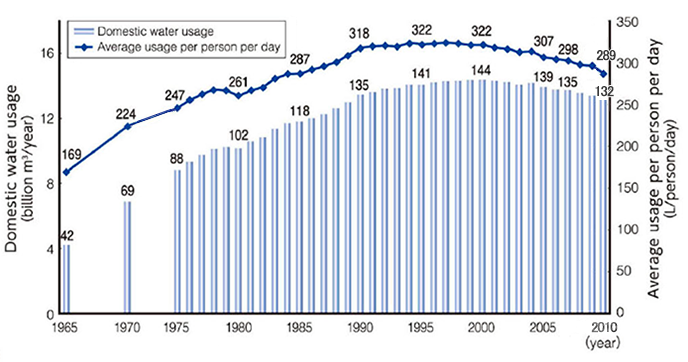
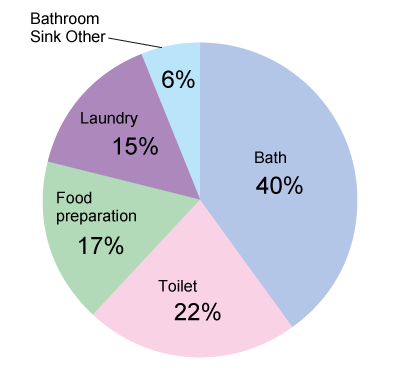
1.Cabinet Office, Government of Japan Consumer Confidence Survey (March 2016)
For a long time, beginning in the 1980s, top loading washing machines were standard, but in the 2000s, front loading machines began to gain popularity. The drum of a front loading washing machine spins around a horizontal axis, washing clothes in a tumbling action that not only causes less wear and tear on the items being washed, but also uses less water, leading to significant water savings. The spread of these washers has fueled a growing trend toward products that can save water while washing effectively. Washing machine manufacturers continue to improve top loading machines as well and have introduced such innovations as pulsator models, fluid recycling and sensors that monitor how dirty the laundry is to save water while washing effectively.
New technologies are also being developed to create detergents that can be used with less water. If one rinse cycle instead of two is enough, a significant volume of water can be saved: 4-57 liters in a top loading machine or 11-33 liters in a front loading machine. By formulating detergents with ingredients that can be effectively rinsed out in less time, detergent manufacturers are making one-rinse washing that doesn't sacrifice cleanness a reality.
The key ingredient of the super-concentrated liquid laundry detergent TOP SUPER NANOX is derived from plants. Methyl ester ethoxylate (MEE), made from vegetable oils found in the kernel of the oil palm, is a proprietary surfactant developed by Lion. Manufactured using new ethoxylation technology that utilizes complex metal oxide catalysts, MEE is a nonionic surfactant that offers a dramatic improvement in detergency and is safe and environmentally friendly. MEE features both excellent detergency and good rinsing performance, making it ideal for saving water while washing effectively. Looking at water savings, in comparisons with alcohol ethoxylate (AE), a surfactant commonly used in detergents, MEE has been found to be more effective at reducing foam during rinsing. This is believed to be a result of MEE's unique molecular structure. In contrast to the linearly structured AE molecule, because MEE is produced from methyl ester, there is a bend in the molecule around the ester group, causing the molecule to take up more space. As a result, fewer molecules align to form foam film, making it easier to wash the foam away. The result of this property is easier rinsing, enabling water conservation through one-rinse laundry.
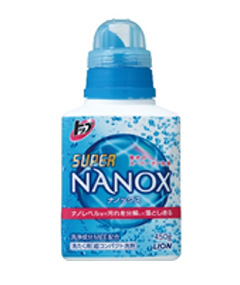
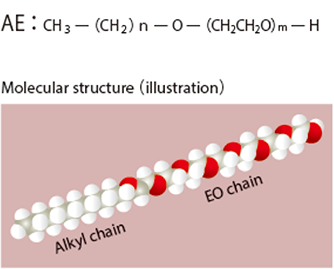
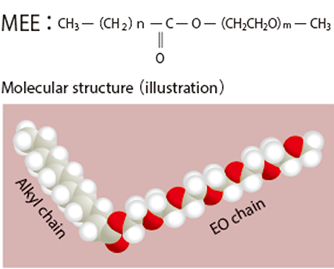
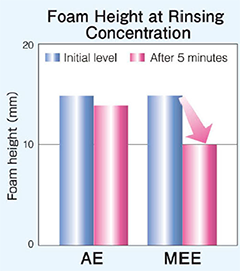
Measurement method: shaking method (15°C)
Measured at a detergent concentration that simulates a rinse cycle using a model detergent formula of 30% surfactant, 5% PEG, 5% ethanol and 1% citric acid, with pH 7.0.
Compared with conventional AE, MEE detergent results in a lower foam height after five minutes during rinsing, indicating superior foam cutting action.
Back to Science Journal Menu